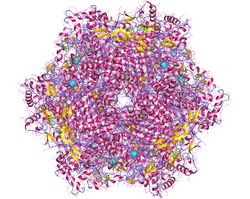Biology:Bromoperoxidase
Bromoperoxidases are enzymes that catalyse the bromination of hydrocarbons. The enzymes accomplish this reaction via the following reaction:
- RH + Br− + 1/2 H2O2 → RBr + H2O
Related chloroperoxidase enzymes effect chlorination.
In the nomenclature of haloperoxidase, bromoperoxidases classically are unable to oxidize chloride at all. For example, eosinophil peroxidase appears to prefer bromide over chloride, yet is not considered a bromoperoxidase because it is able to use chloride.
The bromoperoxidase enzymes belongs to the family of oxidoreductases, specifically those acting on a peroxide as acceptor peroxidases and haloperoxidase.
The bromoperoxidases found in marine algae feature vanadium at the active site (see vanadium bromoperoxidase). Otherwise vanadium is unusual cofactor in biology.[1] By virtue of this family of enzymes, a variety of brominated natural products have been isolated from marine sources.
Murex spp. snails have a bromoperoxidase used to produce Tyrian purple dye. The enzyme is very specific to bromide and physically stable, but has not been characterized as to its active site metal.
References
- ↑ Butler, A., "Vanadium haloperoxidases", Current Opinion in Chemical Biology, 1998, 2, 279-285.


